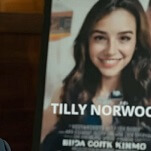During Alan Moore's first extended wilderness period—while Big Numbers was on hold and From Hell was trickling out—Moore made a tentative return to superheroes, signing on as a writer-for-hire on Image Comics' WildC.A.T.S. and on a string of related miniseries and one-shots. The bulk of that work has now been collected by DC's Wildstorm imprint as Alan Moore's Complete WildC.A.T.S. and Alan Moore: Wild Worlds, and though both volumes feature occasional flashes of wit, plus Moore's keen understanding of how and why genre stories work, nothing matches the sense of fun and even piercing brilliance that Moore later brought to Supreme, Youngblood, Glory, and especially his own "America's Best Comics" line. Moore completists should still buy these books, but they ought to know in advance that they'll only be getting better-than-average action-adventure fare from a distracted writer looking for an easy paycheck. This was merely a warm-up for the inspired Moore superhero comics yet to come… Both: B-
Gilbert Hernandez has been on a roll with his recent dreamlike graphic novels Sloth and Chance In Hell—which makes the first installment of his new six-issue miniseries Speak Of The Devil (Dark Horse) that much more of a disappointment. The tale revolves around Val Castillo, a high-school gymnast who decides to don a devil mask and take up nocturnal voyeurism around her suburban neighborhood, turning up titillating secrets along the way. It's akin to Hernandez's previous teen drama, Love And Rockets X, only minus the stratified plot and socioeconomic depth. Instead, SOTD is bogged down by stiff, dull dialogue—uncharacteristic of Hernandez, who seems to have slept through this issue—and populated by stock Hernandez characters like Val's buxom lesbian buddy Patty and the equally vavoom-ish Linda, Val's scandalously young, cocktail-waitress step-mom. Still, the Rear Window-meets-Brick premise is promising enough to warrant a revisit later in the series, and Hernandez's art, as always, is a study in pregnant brushstrokes and pools of shadow… B-
Like Hernandez, Steve Rude came of age in the black-and-white independent explosion of the '80s. Rude quickly graduated to color, though, and his long-running Nexus remains one of the most vibrant, bracing books to ever be peripherally considered a superhero comic. After a hefty run on First Comics and numerous miniseries on Dark Horse, Nexus sputtered out in 1997—but now, Rude and writer/co-creator Mike Baron have relit the flame. Issue 99 (which, if you add all the Dark Horse books to the original series, is sort of accurate) is the first of a four-part Nexus arc subtitled "Space Opera," and it's issued on Rude's own Rude Dude imprint. The numbering and masthead are new, but it's prime Nexus through and through, bursting with all the intrigue, strife, and flashes of joy that comes with being a costumed champion on a refugee planet 500 years in the future. Pouring Jack Kirby's bulging hyper-detail and eye-poking perspectives into the cleaner, sleeker forms of Alex Toth, Rude remains at the top of his game—and he promises three new superhero titles from Rude Dude in 2008: Origami, The Silencer, and The Moth. (The Moth starred in a fabulous Dark Horse miniseries in 2004.) Given the long, involved backstory, the new Nexus might be tough for newcomers to digest, but for old fans, it's sheer comfort food… A-
In addition to writing beloved, award-winning children's books, Shel Silverstein was a successful country-pop songwriter, and a frequent cartooning contributor to Playboy. The book Shel Silverstein Around The World (Fireside) collects a series of illustrated travelogues that Silverstein drew for Playboy between 1957 and '68, and it's noteworthy for a couple of reasons. First, for the sheer breadth of places that Silverstein visited, from Moscow to Haight-Ashbury. Second, for his gag-oriented approach to capturing a time and place. When Silverstein visits Hollywood, he draws himself saying, "Sure, you hear rumors about all the homosexuals in Hollywood, but you don't see any evidence," to a man wearing high heels. Did this actually happen? Probably not. But the flavor is right throughout the book, if only because Silverstein revels in the stereotypes of his era, but also enjoys debunking them… A-
With DC's All-Flash #1 and The Flash #231, writer Mark Waid returns to the superhero with whom he's most identified, and over these two issues, at least, the homecoming feels warm. The jury's still out on whether Daniel Acuña's abstracted faux-animation-cel style really suits the fastest man alive, but there's little to quibble about with Waid's fleet storytelling. Waid reintroduces the recently absent Wally West, now with two semi-grown super-powered children, then drops hints about where he's been, while rushing into a new, action-packed adventure. It appears Waid may be leaning too much on the deterministic "here's what's going to happen to The Flash in the future, so get ready for it" plotting method that made the title such a drag toward the end of his mid-'90s tenure, but the Flash Family angle looks promising, and it may let Waid show some of the feel for young characters that he brought to the much-missed Impulse… B+
The "Batgirl primps while Batman fights" cover of Showcase Presents: Batgirl (DC) has drawn a lot of flak from online comics columnists, with good reason: Of the book's 550 pages of Batgirl stories—covering 1967-1975—only one story, "Batgirl's Costume Cut-Ups," really makes an issue of her "feminine vanity." Granted, some of the other '60s stories are equally goofy, but the character and her creative team really came into their own in the '70s, in a series of eight-page Detective Comics backup stories that combine pulpy mysteries with stylish superheroics. It's this Batgirl—sharp and tough—that fans still miss… B
One good thing came of Teenage Mutant Ninja Turtles: the Xeric Foundation, a nonprofit that TMNT co-creator Peter Laird founded to award grants to struggling comics self-publishers. Past Xeric winners include Adrian Tomine, Jason Lutes, Jessica Abel, and Megan Kelso, all of whom went on to make some of the best comics of the past 15 years. Aron Nels Steinke was one of 2006's winners—and if issue three of his Big Plans is any indication, he'll be following in his predecessors' footsteps. Steinke's immaculately produced yet raw mini-comic is about as good as the format gets: Cute, deceptively simple figures frisk across black pages as the cartoonist dives into the solipsistic tangle of autobio narrative. Previous issues have humbly tackled topics like airport paranoia and the elusive nature of childhood memory, but Big Plans #3 is the farthest-reaching yet most personal to date. Steinke—a Portland indie kid who obsesses over his comics as well as their place in his life—gets invited to attend the 2005 Academy Awards by a friend who works in the film industry. Somewhat predictably, Steinke swills complimentary cognac, stalks Mickey Rooney in the men's room, and becomes infatuated with his friend's coworker, but he delivers the tale with an intoxicating mix of self-deprecation and quiet confidence. Steinke's bold, solid art recalls Joe Matt's early Cartoon Diary work as well as Kelso's sweeter, homespun style, and its gravity and humor balance perfectly. Big Plans was recently picked up by Diamond Distributors—rare for a mini-comic—so it should be available at any comics shop enlightened enough to order it. Otherwise, visit aronnelssteinke.com to get acquainted with one of the best young underground cartoonists on the scene… A-
Lodged somewhere between classic underground comix and lowbrow art is Travis "Fudge" Millard's Hey Fudge (Narrow). The thick trade paperback—packaged in a gorgeous linen-bound, "flexi-cover" format—is comprised mostly of Millard's blobby, surreal pinups and portraits of everything from monsters to monster trucks. As sketchbooks go, though, it's a real feast, with desultory scribbles giving way to fully developed (in some cases, overdeveloped) collage and graffiti art. The book's best bits, though, are its honest-to-gosh comic strips. The wordless "Michael Jackson In Exile" uses a panel-per-page template to follow the King Of Pop's journey from media fodder to, um, monkey fodder on a desert island. It's a cheap gag, but Millard's rubbery, lovingly rendered buildup is worth the ride. Shorter and sweeter are his three-panel "Naked Lady" strips, not to mention a sequence called "Right Wing Conservatives Getting Racked"—wherein (you guessed it) Millard draws page after page of folks like Jesse Helms and Katherine Harris in the painful throes of boot-to-the-groin-itis. For the frustrated liberals among us, it's great visceral therapy… B
Vertigo's The Un-Men is desperately shooting to be visceral too. The new ongoing series is off to a floundering start with its first issue, a drab, limply executed amalgam of noir and science-fiction horror. The Un-Men—mutated freaks led by the brain-on-a-hand known as Cranius—popped up sporadically in Swamp Thing over the years before starring in the 1994 miniseries American Freak. The end of that story left The Un-Men—revealed as the victims of a military experiment gone unimaginatively awry—as folk heroes granted reservation land as an act of government contrition. In The Un-Men #1, the reservation has become a "freak-themed tourist destination" festering with secrets even more grotesque than its inhabitants. Sounds like a great concept—if artist Mike Hawthorne had been able to dredge up visuals to match. Instead, his creatures are either jarringly silly or flat-out lame (a man with a third arm coming out of his chest, a woman with a third breast coming out of her back, a one-armed woman with… oh, never mind). Writer John Whalen doesn't do any better; he stuffs his word balloons with horrendous purple dialogue and reams of leaden exposition. Unless a radical shift in creative personnel happens soon, approach The Un-Men with caution… D
Since 2004, Paul Madonna has been writing and drawing the offbeat strip All Over Coffee (City Lights) for The San Francisco Chronicle, matching lovely, subtle-hued sketches of Bay Area cityscapes with captions that appear to be pieces of overheard conversations, although Madonna explains in the afterword that they all originate with him. In a nutshell, the strip is like the West Coast version of Ben Katchor's crimped, otherworldly New York stories, with Katchor's quest for lost alleyways replaced by broad vistas and elliptical philosophizing. (Typical caption: "I stared at you staring into the distance. You looked lost in a way I wish more people looked.") All Over Coffee can come off as precious when read in big batches, but it's stunningly rendered, and taken a page at a time, it's frequently breathtaking… B+
The Complete Peanuts: 1965 To 1966 (Fantagraphics) features an introduction by indie film director Hal Hartley, who pontificates persuasively on Charles Schulz's ability to be simultaneously "ironic and kind." But to better understand the greatest comic strip of all time, just start reading any random page. Take for example the Sunday strip where Charlie Brown walks seven blocks behind The Little Red-Haired Girl, marveling that he can share the same sidewalk as his crush. His reverie is broken when he realizes that he's never going to get the courage to talk to her. Then he sees Snoopy and says, "You're not much of a substitute for a little red-haired girl," which prompts Snoopy, alone in the final panel, to think, "Quite often lately I have the feeling I don't know what's going on." The strip is a variation on at least three running gags, but Schulz makes the heartbreak and disappointment feel fresh, as he re-emphasizes how a deeply painful moment for one person can be just another lazy afternoon for someone else. That's either a reassuring thought, or a coldly harsh one… A
Since shifting his focus from his character-based strip Too Much Coffee Man to the broader, more philosophical How To Be Happy, indie artist (and Onion comics contributor) Shannon Wheeler has been tinkering regularly with his format and content. His latest collection, Screw Heaven, When I Die I'm Going To Mars (Dark Horse), actually shows the results of that experimentation far more than his last book, the How To Be Happy collection. Screw Heaven includes some Too Much Coffee Man strips (including a rare multi-strip story arc), a number of wry strips about love that recall Matt Groening's early work in tone (though not in way-too-busy list-making format), some particularly silly diversions (like the one about bottling and marketing farts), and a whole lot of other stuff. The book reads like a catchall roundup of musings with no fixed theme, but that's fine, given some of the terrific directions it goes in—especially the hilarious autobiographical arc about a college architecture project. The angry, frustrated political cartoons are less insightful, and they blend oddly with the lyrical musings about art and creativity, or the joyfully satirical strips about consumerism and American society. All in all, it's a distracted, random bundle, but it's frequently sweet, entertaining, smart, or all of the above. B+







































